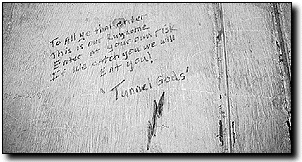![]()
![[ NEWS ]](/images/fall97/newsf97.gif)
By Bryon Wells
Arizona Daily Wildcat March 24, 1998
Tunneling through the UA's bowels
![[Picture]](01_4_i.gif)
Charles C. Labenz Facilities Management's William Patterson stands above a small tunnel to the Main Library as he checks for leaks in the pipes. |
Only the sound of crunching gravel is audible as William Patterson walks
the tunnels 20 feet below the University of Arizona.
Employed by Facilities Management as a staff technician, Patterson maintains the 15-mile dark labyrinth of wires, pipes and cement walls - cut off from the hustle of students above.
The silence is broken at times by the tinking sound of pipes settling or the hiss of pressurized steam, but for the most part, the tunnels remain eerily quiet.
"Sometimes when you're alone, and you've just watched a scary movie the night before, you get to hearing your own footsteps," Patterson said. "I've had times when I've stopped and wondered, is someone walking behind me?"
The veteran tunnel-walker has spent much of his 26-year UA career roaming the dark passages with flashlight in hand, checking for breaches in water pipes and repairing leaks when necessary.
For the last 50 years, the tunnel system has channeled steam through huge pipes to various locations on the UA campus and as far as the University Medical Center, said Lang Lawrence, a Facilities Management engineer.
Overhead and along the walls, pipes running 120 pounds per square inch of steam provide heat and hot water for campus buildings, Patterson said. Smaller plastic pipes funnel recycled water to irrigate lawns and flowerbeds above ground, and chilled water circulates through the vessels to air conditioners and back to giant swamp cooler-like chiller towers at the central power plant.
No rats are in these tunnels, Patterson said, but there's the occasional stray cat or ground squirrel that gets lost in the maze of passages.
"It was quite scary to be walking along and one of them would be sleeping up on a pipe," he said. "It'd jump off and scurry away and leave you a little bit stunned for a second."
In the 1970s, a monkey from the Central Animal Facility got into the tunnel system after escaping from its cage and wasn't captured for four to five months.
Patterson said employees were understandably uneasy about entering the tunnels with the monkey roaming around, and the rumor of a worker who was killed during construction and haunts the hollow lairs is a joke that is commonly played upon some of the new employees.
Access to the tunnels can be gained in the basement equipment rooms of most UA buildings, but are gated and locked to keep students out.
"Once in a while we get some people that get in here, and security has to come and get them," Patterson said.
Patterson said students have always been sneaking into the tunnels, especially during the 1980s, when Dungeons and Dragons fanatics used to break in to play the game in the dark corridors under the campus.
The tunnel is warm in some areas because of the steam lines, which generate enough heat to place the insulated copper and steel pipes in a constant state of flux. The pipes sit atop rollers fixed to the tunnel walls near piston-like expansion joints, which allow leeway for expansion and contraction.
It is here, near the joints, where most leaks occur, Patterson said.
Three small leaks in the steam line did not alarm Patterson as he walked his rounds.
"We have 15 miles of tunnel, so this can happen on a daily basis," he added.
Sometimes Patterson discovers a leak by mistake.

Charles C. Labenz Uninvited guests have been caught down in the tunnel system while others just left their mark. It is believed that a popular fantasy game, Dungeons and Dragons, influenced some to enter the tunnels during the '80s. |
"We got another one," he said, casually brushing a few drops of the 120-degree water from his arm after a spray from a steam pipe.
Small leaks from the steam lines are easily fixed, but the chilled water pipes can burst open from the normal wear and tear of expansion and contraction and flood an entire section of tunnel, Patterson said.
Electrical power used to surge through networks of cables in the underground passages until floods from burst water lines proved that electricity and water were too hazardous a mixture.
Patterson recalled a flash flood in the tunnel under Bear Down Gym during the 1970s, when a Facilities Management worker strapped on scuba gear and braved the 42-degree water to shut off the valve so the water could be pumped out.
Some of the tunnels still have power lines running through them, but most of the big power cables, some with as many as 4,000 volts surging through them, have been moved "topside," Patterson said.
About 90 University of Arizona buildings rely on the boilers at the central power plant - the heart of the campus - to pump in hot water, electricity and heat during cold February mornings.
The central plant, housing gigantic natural gas-fired boilers, was built in 1950, about the same time the tunnels were built, Lawrence said.
Patterson said he could understand why adventurous students want to explore the tunnels once and awhile, but after about 26 years of working in the cement burrows, he is ready to retire to a life above ground.
"After a full day of working down there, it gets pretty tedious," he said. "You learn to appreciate sunlight and fresh air."



